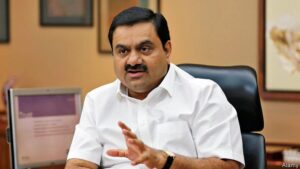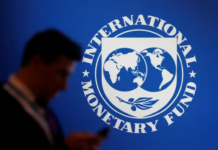
The Economist 30 Jauary 2023
What is at stake as Hindenburg Research picks a fight with India’s mightiest tycoon?
2D0N97D Indian billionaire Gautam Adani speaks during an interview with Reuters at his office in the western Indian city of Ahmedabad April 2, 2014. The way billionaire Indian infrastructure-builder Adani sees it, working with the government does not make him a crony-capitalist. Adani’s rapid ascent to the top tier of Indian business is often associated with the rise of Narendra Modi, the Hindu nationalist opposition leader widely expected to become India’s next prime minister once the country’s election ends next month. Its flagship Adani Enterprises soared 22.9 percent for its biggest daily gain on
Jan 27th 2023 | MUMBAI
Editor’s note (January 30th 2023): The Adani Group has published a 413-page rebuttal to claims by Hindenburg Research, a short-seller, that its share prices have been artificially inflated. The market value of the seven listed Adani Group firms has fallen by about 30% since Hindenburg published its analysis.
From meagre beginnings in the 1980s, Gautam Adani has emerged as India’s richest citizen. Now, in just a few days, the foundations of his sprawling empire have been shaken. On January 24th a small New York investment firm, Hindenburg Research, published a report calling the Adani Group “the largest con in corporate history”. In a series of statements, the group responded by saying that the report was “maliciously mischievous”, “unresearched” and intended to “sabotage” a secondary share offering of the group’s flagship listed company, Adani Enterprises. The group also said that Hindenburg had published its report “without making any attempt to contact us or verify the factual matrix”. “We are deeply disturbed by this intentional and reckless attempt by a foreign entity to mislead the investor community and the general public,” wrote the group’s top lawyer, Jatin Jalundhwala.
These fierce denials have not averted a sell-off of shares in Mr Adani’s seven listed companies, first right after Hindenburg’s report was published, then again when markets reopened on January 27th after a public holiday. In two trading days the collective market value of the Adani Group’s listed firms fell by $47bn, or 22%. Mr Adani’s personal fortune declined from $122bn at the end of 2022 to $93bn, according to the Hurun Report, a research firm. The episode has also drawn the world’s attention to one of India’s corporate success stories—and a significant motor of the country’s recent economic growth.
In targeting Mr Adani, Hindenburg could not have selected a bigger whale. After dropping out of school at the age of 16, the entrepreneur moved through a succession of jobs, trading first in diamonds, then in metals and cereals, before entering the infrastructure business. Today his firms run some of India’s biggest ports, warehouse 30% of its grain, operate a fifth of its power-transmission lines, accommodate a quarter of its commercial air traffic, and produce perhaps a fifth of its cement. An affiliated Singaporean joint venture vies to be India’s largest food company. The Adani Group has also invested in strategically located ports in Australia, Israel and Sri Lanka.
In the last financial year the group’s listed companies had total revenues of $25bn, equivalent to 0.7% of Indian gdp, and a net profit of $1.8bn. Their combined annual capital spending of around $5bn accounts for 4% of the total for all non-financial public companies in India. And Mr Adani’s plans are grander still. Between 2023 and 2027 the group is forecast to spend more than $50bn on investments, including in clean energy and hydrogen.
Mr Adani is widely regarded as a master operator, with a genius for navigating the complicated legal and political landscape of Indian capitalism. Some investors have, though, occasionally expressed concerns about his group’s governance and opaque finances. That is the focus of Hindenburg’s report. It describes a complex network of funds and shell companies, some based in Mauritius, which interact with 578 subsidiaries spread through the seven publicly listed firms. Last year, Hindenburg claims, these entities engaged in 6,025 related-party transactions.
Byzantine corporate structures are common in India and other emerging markets. But the report contends that the Adani Group is “engaged in a brazen stock-manipulation and accounting-fraud scheme”. The point of the complexity, Hindenburg alleges, is to manipulate the listed firms’ share prices and to shift money onto their balance-sheets “to maintain the appearance of financial health and solvency” amid high debts and relatively few liquid assets.
As a consequence, Hindenburg wrote, valuations for the companies were overstated by as much as 85% and financial holes were temporarily papered over, despite severe shortages of liquid assets in five of the public firms. The group’s “obvious accounting irregularities and sketchy dealings” were enabled by “virtually non-existent financial controls”. Hindenburg claimed that Adani Enterprises had 156 subsidiaries but its reports were audited and signed off by a tiny accounting firm employing a handful of people, including some in their early 20s.
Such allegations, the Adani Group said, have been “tested and rejected by India’s highest courts”. On January 27th the group released a PowerPoint presentation rebutting Hindenburg’s claims. Specifically, it noted that the group’s indebtedness is decreasing, and the operating companies’ debt issuance had been classed as investment grade by various rating agencies. It added that multiple accounting firms had been used to provide audits. Mr Jalundhwala said that Hindenburg’s report had led to “unwanted anguish for Indian citizens” and adversely affected the company and its shareholders. “We are evaluating the relevant provisions under us and Indian laws for remedial and punitive action against Hindenburg Research,” Mr Jalundhwala wrote.
Hindenburg responded on Twitter that it stood by its report and that it welcomed the prospect of legal action, especially in America. “We have a long list of documents we would demand in a legal discovery process,” the investment firm said.
For the time being, the report has upended Adani Enterprises’ much-anticipated secondary share offering. This was intended to raise around $2.5bn in new capital, in part to reduce debt. The first stage of the offering, accounting for 30% of the capital-raising, took place on January 25th and was fully subscribed, raising $735m. Several prominent investors put in bids, including the Abu Dhabi Investment Authority, Life Insurance Company of India, and entities related to two American banks, Goldman Sachs and Morgan Stanley. Since then Adani Enterprises’ share price has fallen below the offer price. The bigger public portion of the offering, which began on January 27th and was meant to conclude on January 31st, has so far attracted almost no buyers.









